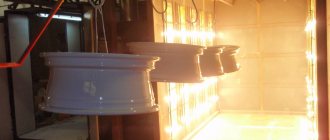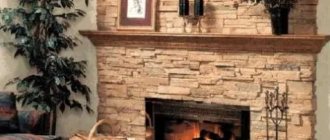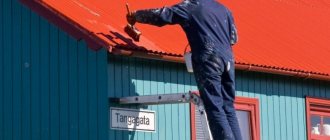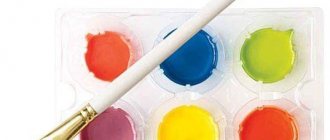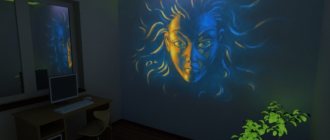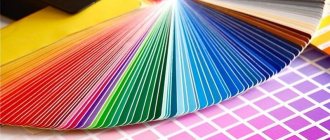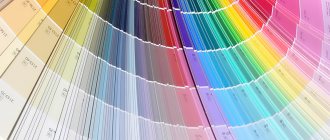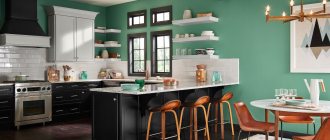The polymerization chamber (also called drying ovens, reflow boxes, etc.) for powder paint is designed to perform the final stage of painting parts. It heats the coating and distributes it evenly over the surface, which is why these devices are sometimes called reflow chambers and drying boxes. Equipment of this type is subject to a number of specific requirements related to the peculiarities of powder coating technology.
Making a furnace
The manufacture of a powder paint polymerization oven should begin with calculations and a clear understanding of what will be painted in this oven
Dimensions are very important, since the larger the oven, the more energy will be required to warm it up, and the more time it will take to reach the optimal temperature
On the other hand, the chamber must contain all the products to be painted in such a way that they do not come into contact with each other.
Advice! It is not practical to make a chamber for one-time painting; it will be much easier to order this work from specialists.
For example, today, cars are often painted with powder paints, and therefore the chamber must accommodate the entire car, and at the same time, there must be a margin of at least 30-50 centimeters on each side.
If you have decided on this question, then the next step is to compile a list of everything you will need:
- Profile pipe, no less than 40 by 20 mm, to create a frame.
- Basalt wool, 50 mm thick.
- Galvanized steel sheets.
- Double-action fan with ducts for air circulation inside the chamber, distributing temperature throughout the entire volume.
- Heating elements are designed so that the temperature in the chamber rises to 200 degrees. For accurate calculations of the number of heating elements, it is better to contact specialists.
- Control unit with thermostat and thermostat.
- Two thermocouples for measuring temperature at the bottom and top of the chamber.
Frame
The frame is made of a profile pipe in such a way that it is possible to lay sheets of basalt wool inside. You can use a pipe of any size as a material; the main thing is to remember that the thicker the insulation layer, the faster and longer the temperature will be maintained inside the chamber.
The door of the frame is also welded from profiles and insulated; in addition, it is necessary to provide a latch that will not only hold the door in the closed position, but also press it tightly against the frame itself.
When the frame is assembled, it must be sheathed on the outside with metal sheets so that the insulation has support. Basalt wool is laid into all voids, and the more densely it is laid, the better the oven will maintain its temperature.
After insulation, the inside of the frame and door are galvanized. The frame is ready, and it's time to install the attachments.
Heating elements and regulators
At this stage, it is best to seek help from specialist electricians. The high temperature inside the furnace is achieved due to the high power in the network, and accordingly the load will be colossal. It is best if the installed equipment is connected to two phases, that is, the network should not have household 220 volts, but industrial 380.
After attaching the heating elements and bringing the wires out, thermocouples are installed, with one placed as high as possible to the ceiling, and the second at the back wall on the floor. Thus, two thermocouples will give different readings, and the automation will calculate the average temperature in the chamber.
Heating elements and thermocouples are connected to sensors and to the network. The heater is ready, and all that remains is to cover the heating elements with another galvanized sheet. This will protect the product to be painted from uneven heating and contact with exposed electrical wires.
Important! Before sewing up the heating elements with a sheet, you must check the operation of all devices and equipment. Each heating element should heat up evenly, and the automation should turn them off when the desired temperature is reached
Hoods
Forced air circulation is necessary for uniform heating of the chamber. The fan itself should be located outside, and have two entrances into the chamber: one, wider at the top, for air intake, and the second narrow, at the bottom, for injection back. The power of the fan itself is selected individually depending on the size of the chamber.
When the serviceability of all equipment has been checked, hangers are installed under the ceiling on which the painted products will be hung, and you can proceed to trial polymerization.
What does the camera look like?
It is a prefabricated structure, similar to a single module. It has a number of technical characteristics:
- high level of thermal insulation, the outer part of the chamber warms up to no more than +40 °C, although the temperature inside can be more than +200 °C;
- inside the device there are several powerful heating elements that provide rapid heating of the air with minimal energy consumption;
- The heating elements are closed in the inside of the box with heat-reflecting screens, which further accelerates the heating of the air inside and prevents overheating of the heating elements;
- on the top of such a chamber there is always a fan, as well as an air vent, which ensure normal air circulation inside the device;
- All internal mechanisms of the structure are designed so well that its heat loss is minimal and efficiency is high.
Required Equipment
In order for the process of self-painting to be practically no different from the factory one, it is necessary to choose a suitable place where the work will be carried out.
When the premises have been found, you need to collect and prepare the necessary equipment:
- oven for polymerization (drying);
- constant voltage source (about 25 kV);
- powder paint sprayer (gun);
- LMB.
Accuracy and a little experience will not hurt in the work. But if it’s not there, it doesn’t matter; by following the instructions, you can avoid most mistakes and get quite a decent result.
Making a furnace
Polymerization is an important step in the hardening of powder paint. If this item of work is omitted, the paintwork will not adhere to metal surfaces. Therefore, equipment such as a furnace - also called a polymerization chamber - is necessary first of all. This thing is expensive, so you can make it yourself, from scrap materials. We will need (the polymerization chamber will have dimensions of 2x1x1 m):
- profile pipe;
- non-flammable thermal insulation (basalt slab);
- sheet metal (can be ordered by size);
- tangential fan;
- Heating elements.
The oven assembly instructions consist of the following steps:
- Weld a frame from the profile.
- Put insulation in it.
- Cover the walls with sheet metal. Finish the outside with gypsum fiber.
- For convection in the chamber, install a tangential fan, welding it with a narrow outlet and a wide inlet.
- Insert the fan into the chamber. It will take in air at the top, drive it through the heating elements, expel it at the bottom, and then distribute it throughout the entire volume of the chamber.
- Install the heating elements along parallel walls and connect them according to phase distribution.
- Close the heating elements, leaving the fan open, the main part of which should be located outside the chamber (so as not to melt the winding).
- Install an electrical panel. True, it is better to entrust this work to a specialist.
The resulting equipment - a polymerization chamber - will have a power of 12 kW when warming up and 6 kW in operation.
Important! The energy source in such ovens for drying powder paint can be not only electricity, but also natural gas and diesel fuel
Painting tool - gun
To apply powder paint to a product, a special device is required. This is an electrostatic spray gun or a tribostatic powder spray gun. But buying expensive equipment for rare use is not advisable. Since in our case everything is made by hand at home, such a device can be made in about 10 minutes. Such a gun is easy to use, cheap and practical. The transition from one paint to another takes a few seconds.
Design and equipment of a gun for powder painting
How to make a powder paint gun:
- Take a regular plastic 1.5 liter bottle. The main thing is that it is dry and clean.
- Fill it 1/3 with powder paint, screw it with a metal plug.
- Make small holes in the cork. The more holes, the better the application. Clean the outside of the plug from any burrs left after piercing.
- Connect the positive wire from the high-voltage source to the plug.
For this purpose, you need a converter that can deliver 25,000 volts DC. These are used in stun guns, lighters for gas stoves, boilers and speakers. They can be powered by batteries or accumulators, converting 3-6 volts into the required 25 kV.
Use caution when working with high voltage. It is better to have the converter assembled by a qualified electrician.
After all the manipulations, you get a pretty decent pistol.
Little things you can't do without
Before starting painting, you need to carefully ensure that all operations take place under ideal conditions:
- Excellent lighting is essential. Use fluorescent lamps. Powder paint adheres perfectly to a regular lamp.
- You need good ventilation with two motors (inlet and outlet). Additionally, you will have to wear a gauze bandage, or better yet, a professional respirator.
- We will have to invent a way to collect the remaining powder paint. In the initial stages, use an old powerful vacuum cleaner.
When everything is carefully prepared, you can start painting the necessary parts yourself.
Frequently asked questions about powder coating equipment
You can order and buy a line of powder painting equipment from us at a competitive price:| L-shaped powder coating area with bottom transport system | Semi-circular powder coating line with top conveying system | Ring set of powder coating equipment with top transport system |
| Price: 550,000 rub. | Price: 800,000 rub. | Price: 850,000 rub. |
| More details | More details | More details |
All our products are certified and meet all safety requirements and technical parameters
1) What is powder coating?
This is the process of applying polymers (powder) to a metal product and then the polymerization process, which occurs in an oven (polymerization chamber) at a temperature of 120 to 230 degrees C.
2) What is powder coating?
Polymers open at high temperatures (120-230 degrees) and create a durable, anti-corrosion coating (read more about surface preparation).
3) How long does the polymerization process take?
The entire process from spraying to obtaining finished painted products takes approximately 30-50 minutes (depending on the size of the workpieces and the thickness of the powder paint coating).
4) What is a spray chamber?
Designed for applying powder paint to a product. Having such a chamber, you will not only be able to conveniently spray your products, but will also receive economical consumption of raw materials (powder) and a clean workshop.
5) How does the spraying process take place?
Any of the spraying chambers produced by our company have filters for suction of powder that does not settle on the product during spraying. After a certain time (the time is set on the control panel of the spraying chamber), the powder is discharged into the tank, after which it can be mixed with new powder and reused.
6) What types of cameras do you produce?
We produce 5 types of spraying chambers: a universal open-type spraying chamber for painting various sizes of products, a closed-type spraying chamber of a dead-end type for painting small-sized products, a single-post pass-through chamber, a double-post pass-through chamber and a closed-type pass-through chamber with cyclones (filter block for paint intake, not on the product) for large-sized products.
7) What is a polymerization oven?
Designed to carry out the process of melting powder paint on the surface of products (the process itself occurs at a temperature of 180 degrees C for 20-30 minutes).
 What does the polymerization chamber consist of?
What does the polymerization chamber consist of?
The reflow chamber consists of prefabricated sandwich panels containing inside a thermal insulating material - basalt fiber, heating elements, a control panel, an exhaust fan and an air duct. Prefabricated panels solve the possibility of delivering equipment in disassembled form.
9) How does the chamber heating process occur?
Heating occurs by laminar air flow inside the chamber at a speed of 4 m/sec. using a block of heating elements located on the side of the chamber. The unit is equipped with an electric motor, which ensures uniform air distribution with laminar flow.
10) What types of stoves do you produce?
There are two types of furnaces: walk-through and dead-end.
11) What is a transport system?
It is designed to move products through the painting area from the place where the products are loaded, through the spraying chamber into the polymerization oven and to unload the finished products to the storage location.
12) What types of transport system are there?
The transport system comes in two types: bottom (loading cart on rails or thermal rollers) and top (transport overpass with two carts or a block of guide streams). PS With the option of a lower transport system and a universal spray chamber, a monorail system with a rotating carriage (for turning products) is offered.
13) What is surface preparation equipment?
This is equipment for cleaning metal from contamination and degreasing it. There is also the preparation of metal with various solutions that strengthen the metal coating.
14) What types of surface preparation equipment are there?
There are two types of metal surface treatment: mechanical and chemical.
15) What is machining?
Mechanical processing is usually used for products with a thickness of 2 mm. Because mechanical processing occurs using shot blasting and sandblasting units (using abrasives: shot, sand, glass beads - for decorative processing).
16) What is chemical preparation of metal?
Chemical preparation is designed for washing, degreasing and creating a durable layer using a zinc-phosphate solution.
17) What types of surface preparation installations are there?
There are different types of installations: simply shot-blasting-sandblasting installations, shot-blasting chambers (inhabited and uninhabited), uninhabited shot-blasting units of three types: drum-type for processing small-sized products, closed chambers for hanging medium-sized products, and walk-through chambers with roller conveyors for heavy and large-sized products.
18) What types of equipment for chemical preparation are there?
Typically these are chambers for surface blasting (degreasing and cleaning from contaminants) and chambers with chemical solutions (zinc phosphate).
19) How does powder paint differ from liquid paint?
Firstly, this is a difference in the composition of the raw materials. And secondly, powder paint does not contain toxic waste. Thirdly, powder painting is more economical than painting with liquid paints (due to the use of a spray chamber, which contains a filter unit). Fourthly, powder coating creates a durable anti-corrosion layer (also with good surface preparation), as well as various durable decorative layers.
20) What is the warranty for your equipment?
We provide a 1-year warranty on our equipment (subject to installation by our specialists).
21) How many kW of energy does a powder coating oven consume?
The polymerization chamber consumes 4.4 kW per hour per 1 cubic meter. If the polymerization furnace has internal dimensions (LxWxH) of 3000x1600x1800 mm, then the volume of this furnace will be 8.64 cubic meters. This means that the powder coating oven will consume 8.64 cubic meters. x 4.4 kW/hour = 40 kW/hour
For more detailed information please contact:
Tel.:
8(919)666-10-33
E-mail:
[email protected]
Here
you can read the answers to frequently asked questions.
Powder coating chambers are widely used for coating metal products with polymer-powder materials, such as metal doors and gates, fences (fence sections), gratings, metal cabinets and drawers, fire extinguishers and other fire equipment and inventory, car wheels, various metal profiles ( roofing, etc.), metal furniture (including medical) and fittings, benches and other products for landscaping, window profiles, stationery items, various household appliances, and many other metal products that require painting and which can withstand temperatures from 120 to 250 degrees.
We supply equipment to all cities of Russia: Moscow, St. Petersburg, Nizhny Novgorod, Vladimir, Saransk, Samara, Saratov, Kazan, Izhevsk, Ufa, Kirov, Ulyanovsk, Voronezh, Penza, Perm, Rostov-on-Don, Lipetsk, Krasnodar, Stavropol, Chelyabinsk, Yoshkar-Ola, Volgograd, Yekaterinburg, Tyumen, Tomsk, Tula, Oregburg, Ivanovo, Kaliningrad, Kaluga, Kurgan, Yaroslavl, Novosibirsk, Bryansk, Smolensk, Krasnoyarsk, Ryazan, etc.
Offers from manufacturers
The choice of model is made based on: the type of fuel used during operation, the expected volume of painting, the number of parts that are painted per unit of time.
Manufacturers of powder coating installations, both domestic and foreign, are known on the Russian market:
- Gema Switzerland GmbH is represented in the Russian Federation, which produces special equipment. For inquiries regarding Gema equipment: Gemasabakksk-systems.ru Address: 140005, Moscow region, Lyubertsy, st. Kirova, 20A, 2nd floor;
- Since 1193, Radar Powder Coating Center has been known in Russia as a manufacturer of powder coating equipment. Its central office is located at: 420061, Kazan, st. Nikolay Ershova, 49 B, email: radarsabakaradar-kazan.ru. You can contact in Moscow through the branch: 111024, Moscow, st. Aviamotornaya, 12, of. 50, email: radar2004sabakamail.ru;
- "Antanta" is a manufacturing enterprise that has been producing stoves since 2005. Hotline 8-800-500-44-20 (toll-free within Russia); mail infodogantanta.su.
- Grafix company, Ukraine. Address: Kharkov, st. Lozovskaya, 5, shopping center “Kolbim”, district “Ivanovka”; 0 (800) 759-889 The call is free; mail in.uadoggmail.com.
The lineup
| Model | Description | Price |
| Avetek ALLP powder painting line in Tolyatti | Fences, mechanical engineering parts, and furniture are painted. | 540,000 rubles |
| Chamber furnace with powder coating 4 m thick Electron E4, Germany | Dimensions 4x1.5x1.8 meters, | 13000 euros |
| Polymerization chambers. TU KOPP 3442-001-31848505-03, Ukraine brand Arsenal S | 1500x2000x1500 | dead end |
| 1500x2000x1500 | checkpoint |
258,000 rublesPolymerization chamber
in Stary Oskol, heating is carried out by a thermoblock, which allows for quick maintenance and replacement of heating elements. The equipment is manufactured with the dimensions of the working space: length, height, width of the structure in mm, its power in kW, price of the unit in rubles 2000 × 1800 × 1600 24 215 000; Second model: 2500×1800×1600 29,260,000; Third model: 3000×1800×1600 35,300,000; Fourth model: 3500×1800×1600 40,350,000
Read further:
Powder coating booths
Powder paints: types and properties
Technology of applying polyester powder paint
Painting aluminum products at home
DIY methods for making a spray gun
Let's start painting
And now, the place is prepared, the equipment is installed and the moment comes for which all this was created - painting.
However, there is something to prepare for here, because powder painting at home does not mean painting in your home clothes.
The most important thing when doing powder painting yourself is protecting your respiratory tract and eyes. A molar respirator and regular, clear, safety glasses are suitable for this.
These precautions are related to the specificity of powder paint and its ability to very quickly fill the entire space around it, and its contact with mucous membranes can lead to serious consequences. It also makes sense to protect your hands, for which even medical gloves can be used
It also makes sense to protect your hands, which even medical gloves can do.
https://youtube.com/watch?v=Li-Ocd8xR0U
Otherwise, everything is aimed at maintaining cleanliness in the room, so it is recommended to use white painting overalls, as well as shoe covers.
After putting on all of the above, you can begin to do the work. Depending on the material, shape and size of the product, there are certain nuances in the work.
These are usually related to the pressure level and the gun attachments used.
For example, powder painting wheels with your own hands is a very easy process and requires painstakingness and attention to detail rather than special skills.
In this regard, it is easiest to work with a car body - simple lines, large space, and during the painting process your hand will have time to get used to it and there will be enough experience for subsequent experiments.
Another point to note is related to the application of powder coatings.
Most often, powder painting of metal is required with your own hands, and any metal is quite picky in terms of processing and painting.
Before starting such work, it is necessary to completely rid the room of dust, and also use closed-type fluorescent lamps.
The paint must be applied in at least three layers, moreover, the first must be a primer and have a white or black color (the choice depends on the final color - whether it will be dark or light).
After the primer layer has completely dried, you can proceed directly to painting.
Using powder paint to restore a car's paintwork allows you to obtain a high-quality polymer coating, which, in addition to its excellent appearance, is also characterized by increased protective properties. This coating technology was developed back in the 50s. In most cases, unlike standard enamels, powder paint after application can be heat treated in a chamber, melting, and forms a reliable protective layer on the metal parts of the body.
Paint is applied using a special powder coating gun, which has its own characteristics and differences in comparison with the enamel spray guns that are already familiar to us.
Features of the powder coating chamber device
Any powder coating booth usually consists of two main systems. This is high-quality air filtration, as well as powder recovery. Before the dyeing process, the powder must undergo a certain magnetization, which gives it a certain pole of the magnetic field. Here the second pole is the vehicle body. During the painting process, the powder adheres to the metal in a uniform and dense layer.
After the paint is applied, the layer is baked. For this purpose, the body will need to be heated literally to 160-180 degrees. When carrying out this process, the powder melts a little, but it should remain in this temperature mode for at least 10 minutes, preferably 20.
If such painting is carried out in a production environment, then it is used to paint not only the body, but also bumpers, wheel rims, headlight reflectors and plastic parts. Nowadays, special powder paint with a matte or leather-like effect is widely used.
As for the household dyeing method, the use of simpler materials and methods is quite sufficient. You need to follow the above tips and your powder paint booth will be ready.
What equipment is needed for DIY powder coating - list and tips
This painting technique is, without exaggeration, the most effective. Using special equipment by spraying the prepared composition, you can qualitatively treat any surface, regardless of its configuration and the possibility of free access to it. This is precisely what in many cases limits the use of traditional devices - rollers, brushes, tampons. Powder painting has no such disadvantages.
Considering the noted difficulties associated with industrial processing of materials, it is advisable to organize powder coating yourself. Moreover, there is nothing particularly new in this technique, since almost every person has at least once encountered cans containing an aerosol. Whether polishing furniture, priming the base, or something else - regardless of the type of composition used and the specifics of the work, the general principle of its implementation is exactly the same. Let's figure out what equipment we need for powder painting.
Production area
There may be 2 options here - either use a suitable room (if the “object” is large), for example, a barn, garage, or build a separate chamber. Of course, there is no point in spending money on a large room, especially for occasional use, but any owner can easily assemble a small spray booth on his own.
In essence, this is a regular frame technology - “skeleton” + cladding. If the area of the local area allows, then there is nothing complicated in installation. And the materials used will be useful somewhere else. Before painting, the walls (to protect them) are covered with any consumable material, which you don’t mind throwing away later.
In any case, the following requirements must be met:
- ensure space closure (at least relative);
- equip the room with effective ventilation;
- install a thermal control system.
Powder technology consists of two stages - coloring and polymerization at high temperatures (drying). Based on this, the necessary devices are selected. We will list what you will need, and at the same time note the estimated prices for certain types of equipment.
Compressor
For domestic use, a 5 atm model is quite suitable. Naturally, you will have to purchase it. Even if you plan to paint the car, it is quite possible to keep it to 10,000 rubles. For example, the price of a German model (at 8 a is 8,355 rubles.
Hood
Depending on the size of the “chamber,” you will have to install a strong fan (which means its engine must be appropriate). When its dimensions and volume of work are small, a vacuum cleaner is often used for this purpose. Naturally, with sufficient power and always with a cyclone-type nozzle.
Drying cabinet
If the work is carried out in a utility room (for example, in a garage), then to warm it up you can use either heating elements correctly placed throughout the entire area (connected in a common circuit) or electric heaters (reflectors). They dry the air well, and this is considered a disadvantage of such devices. But in this case it is a big plus.
It is only necessary to place all the heaters correctly to ensure uniform drying over the entire treated area.
Energy supply
During the powder coating process, you will need to connect both a compressor and an oven.
Therefore, it is necessary to pay attention to the electrical wiring - how much load power can it withstand?
Lighting
Considering that the air will be saturated with vapor, it is recommended to install fluorescent lamps, and always of a closed type.
A separate topic is the quality of power supply. Our electric networks are not characterized by voltage stability, especially in rural areas. The peculiarity of powder technology is that the uniformity of application of the composition to the treated base is extremely important. Otherwise, it is impossible to achieve the required “shine” of the metal (by the way, we wrote about chrome plating here). Therefore, you will have to think about a stabilizer or UPS.
This article provides only a general overview of the required equipment. Its selection is determined by the specifics of the work, the practical skills of the master, financial capabilities and a number of other factors. To apply this technique in everyday life, all of the above is quite enough.
voice
Article rating
Requirements for polymerization chambers for powder coating
When purchasing equipment, it is important to take into account the special process conditions and equipment requirements:
- the working space of the chamber must be completely and evenly heated with an equal rate of temperature increase in all zones;
- the permissible gradient is no more than 5 C, regardless of the temperature measurement points in the polymerization oven;
- if necessary, controlled airflow of parts should be provided;
- For full use of the room, it is necessary to achieve a minimum wall thickness while maintaining minimal thermal conductivity.
The design of polymerization furnaces is carried out taking into account these features; the design allows the equipment to be adapted to production conditions of different scales.
Camera and equipment
The camera and equipment affect not only the quality of the work, but also the very possibility of carrying it out.
The fact is that powder painting itself is easy to do, but preparation for it is quite complicated.
- Organize a fully functional camera;
- Use the “garage” option.
In both cases, certain costs cannot be avoided, but first things first.
First, you need to decide on the size of the products to be powder coated.
The fact is that painting large objects (for example, a car body) not only requires a large space, but also very powerful equipment and it is not advisable to purchase it for a single use.
Of course, you can use what is called what you have, but at your own peril and risk.
In general, a self-made powder painting booth should look like an enclosed room with good ventilation and a stove (or air heating system).
Here it is worth making a small digression and talking about a mandatory element that will be present in the painting chamber, regardless of its size and the specifics of the products.
If you are determined to do all the work yourself, then you need to know that some do-it-yourself powder painting equipment is no different from professional equipment.
If the organization of a painting chamber can be done using scrap materials, neglecting special ovens, ventilation, etc., then in the case of a paint supply and spraying system, an amateurish approach is inappropriate.
Therefore, it is strongly recommended to purchase a high-quality paint gun that can withstand a pressure of at least two atmospheres, as well as a compressor capable of providing pressure up to 5 atmospheres.
Let's get back to organizing the camera.
If you decide to do the “Garage option” of powder painting with your own hands, then the first thing you need to do is clean the room as much as possible, ridding it of dust and everything unnecessary.
Powder paint does not tolerate dust, so you should be as careful as possible.
You should take care in advance to improve the quality of the electrical wiring, because the operation of the compressor will require quite a lot of electricity, just like for subsequent drying.
Speaking of drying, for the homemade version you can use electric heaters, setting them to high power, the main thing is not to forget about safety and try to do everything possible to avoid a fire.
When setting up a paint booth, as they say, “from scratch,” in addition to ventilation and a high-quality power supply network, it is necessary to install the most important element - a furnace.
There are many offers on the market with different dimensions, but this is not the cheapest purchase. With great desire and some skill, you can make it yourself.
Their diagrams can be found on the Internet, and if you have experience in creating such devices, then it will be enough for you to know that heating should be uniform and at a temperature of no more than 300 degrees.
And also, make sure you have a high-quality vacuum cleaner, preferably one with a cyclone attachment (regular ones clog quickly).
The fact is that it is necessary to maintain the highest possible level of cleanliness in the chamber, and in this case, a powerful vacuum cleaner will be the best option.
Ventilation arrangement in a paint booth
After preliminary calculations, a ventilation scheme for the paint booth is drawn up. Its design depends on the size of the room and climatic conditions.
Arrangement
The choice of ventilation equipment in the painting booth is made after determining the air exchange rate in the finishing and drying mode of painted products.
It should be remembered that the installation of filter elements is a prerequisite for construction. The cloud formed during operation of the spray gun is harmful to human health and the environment.
The ventilation of the spray booth is arranged with your own hands in the following sequence:
- Applying markings to the ceiling, floor and walls. Arranging a hole for the supply fan. The opening is immediately closed with a box that will protect the equipment from precipitation and trap large debris, insects and small animals.
- Installation of injection equipment. It is installed directly above the opening. Fastening is carried out to the ceiling slab with anchor bolts.
- Channel laying. The box is made of stainless steel sheets, aluminum or large diameter plastic pipes. The cross section is selected based on calculations. The parts are connected using couplings or flanges.
- Installation of filters to remove dust from the incoming air. You can make them yourself or purchase ready-made products. Rough cleaning is carried out in a polypropylene filter. Final cleaning is carried out using activated carbon, which absorbs organic compounds, oil and fat fumes.
- Installation of heater. The device is mounted in such a way that it is easy to reach for inspection, maintenance and repair.
- Installation of the hood. A groove is made in the floor connecting the hole in the floor and the bottom of the wall. Sheet steel is laid over the trench and the edges are sealed. An exhaust fan and an absorber filter are inserted into the wall.
Upon completion of installation, the system is operational in all modes. Then the consequences of the work are eliminated and painting equipment is installed.
Forming a coating
After the powder paint is applied, the product undergoes the next process - coating formation. It consists in straightening the applied composition. As a result, a film forms on the coating, hardening and cooling of the applied layer occurs.
The temperature should be around 2100C. This procedure lasts one quarter of an hour. It is advisable to maintain a stable temperature regime in the paint shop, but there is no special prohibition on opening the oven. After the required time has passed, the product is removed from the chamber and cooled naturally.
It should be remembered that heated metal is softer than in its normal state. Therefore, it should be placed so that it is not accidentally subjected to mechanical stress or deformed.
It should be noted that coatings that are painted with powder paint are of high quality and degree of resistance to mechanical abrasion. This coating will last a long time. In addition, the powders that are used for application to metal and other surfaces themselves have high-quality properties.
As you can see, the DIY dyeing technology is not at all complicated and it is quite possible to do it. The main thing is to follow all the advice while working and not skip the preparatory stages.
Application of powder paint (20 photos)
Main functions of the polymerization chamber
The main purpose of the polymerization chamber is to heat the space inside it to a certain (very high) temperature and maintain it for a long time. This allows the powder paint composition to evenly melt and spread over the entire paint surface. This improves the coloring of the product and ensures smooth and uniform spreading of the layer. Due to such processes, the chemical composition of the paint is completely polymerized, which contributes to a high level of bonding between the paint and the surface of the product.
Each polymerization chamber model has its own range of temperatures that it is capable of recreating and maintaining. It is worth familiarizing yourself with it at the stage of choosing a specific model. The functionality of the device largely depends on this range.
Polymerization chambers have become invaluable assistants in those areas where various products are actively painted with powder compositions. It copes with its functions perfectly and increases the quality of such coloring many times over. Its functionality will be relevant for those areas where it is necessary to heat other substances to high temperatures and maintain them in this state for a certain time.
Powder application process
After completing the preparatory work and before painting the calipers with powder paint, we proceed directly to applying the composition. To do this, the product is placed in a chamber, which has several priorities before painting directly in the garage:
- traps powder particles and prevents them from spreading throughout the garage;
- ensures the disposal of waste that has not yet settled on the surface to be painted;
- provides good filtration.
You can paint calipers or discs directly on the car without dismantling them. This is a simple operation, but when performing it there is a risk of paint getting onto adjacent parts that do not need to be painted. The quality of the result is affected by weather conditions and wind direction.
The dyeing technology consists of the following steps:
- Painting at home begins with preparing the dye. To achieve the desired shade, take powders of several colors and mix.
- We prepare a respirator, gloves and goggles to protect against the effects of the composition.
- After the first layer has been sprayed, leave it to dry. The first layer is never perfect. The thickness of the powder paint layer is not too large, so a single application is not enough.
- The number of layers can vary, from 4 to 10. Apply until the thickness of the powder paint coating is ideal.
- The polymer coating is applied using a sprayer, which is positioned during the process at a distance of 25–30 cm from the surface to be painted.
Design Features
The main material used to manufacture this device is sandwich panels. Thanks to this solution, the customer can independently assemble the equipment on his own territory in a short time. The installation process is somewhat reminiscent of Lego. A big advantage of this design is the possibility of further modernization of the equipment: the furnace can be increased in volume, increased in length, and also dismantled or moved to another site.
The oven frame is made of metal sheets, which have a thickness of about 1.2-1.5 mm. The interior is lined with galvanized steel, and the exterior elements are powder coated. There is also thermal insulation material on the inside.
Furnaces can be divided according to the type of heating. At the moment, experts identify three main options that are focused on the specific needs of the client: gas, diesel or electricity.
Types of polymerization furnaces
If we simplify the classification of polymerization furnaces, we can distinguish two main types that are actively used in production:
- Dead-end or continuous convection oven. In this case, an infrared incandescent lamp is used, which heats the inside of the equipment. All lamps are connected in parallel: about 6-8 pieces can be present in one block. The heating level of the lamps can only be controlled visually by periodically opening the doors. The system also provides an automatic control panel. Using such a control system, you can regulate several parameters at once: heating temperature, baking time of the product; temperature difference delta. In general, the customer can carry out the following operations using remote control: supplying voltage to all components, measuring the temperature level in the device, monitoring electric heating devices.
- Polymerization oven with thermoblock and convection. In this case, the type of heating used is a 2 kW heating element. For ease of control, they are installed in a separate thermoblock. From this element, thermal energy spreads throughout the entire area and volume of the furnace - this effect is achieved through the use of ventilation ducts.
